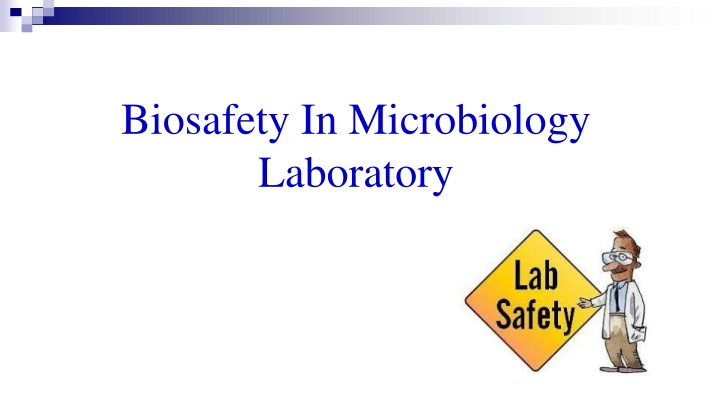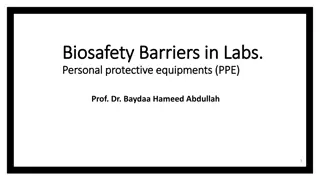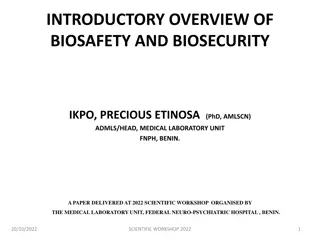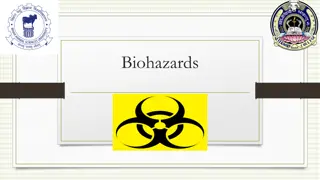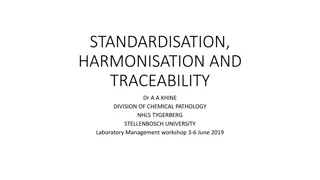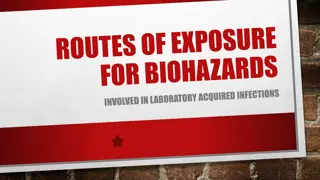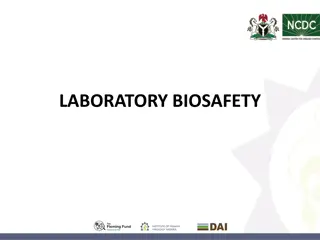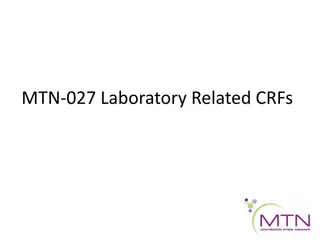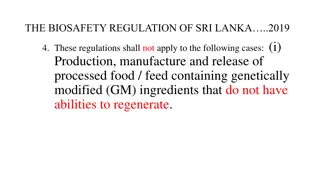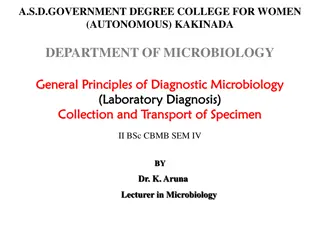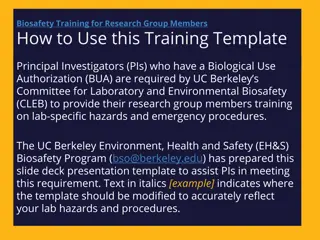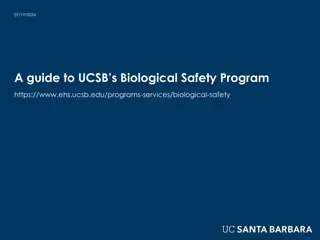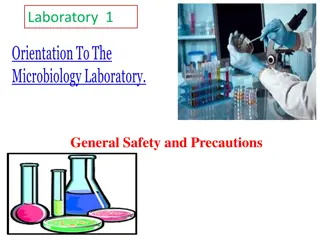Biosafety In Microbiology Laboratory
Biosafety practices are crucial in microbiology laboratories to protect workers, products, co-workers, and the environment from potential hazards like bacteria, viruses, fungi, human blood, unfixed tissue, human cell lines, and recombinant DNA. These practices encompass preventing lab-acquired infections and managing hazards associated with laboratory operations and equipment. Understanding biosafety levels of agents, such as BSL1 to BSL4, helps in classifying the potential risks posed by different microorganisms and ensures appropriate safety measures are in place.
Download Presentation

Please find below an Image/Link to download the presentation.
The content on the website is provided AS IS for your information and personal use only. It may not be sold, licensed, or shared on other websites without obtaining consent from the author.If you encounter any issues during the download, it is possible that the publisher has removed the file from their server.
You are allowed to download the files provided on this website for personal or commercial use, subject to the condition that they are used lawfully. All files are the property of their respective owners.
The content on the website is provided AS IS for your information and personal use only. It may not be sold, licensed, or shared on other websites without obtaining consent from the author.
E N D
Presentation Transcript
Biosafety In Microbiology Laboratory
Why Biosafety practices? Protection: Workers products Co-workers Environment
Biosafety: preventing lab. acquired infections Bacteria Viruses Fungi Human blood Unfixed tissue Human cell line Recombinant DNA
Examples of laboratory Hazards Operation / Equipment Hazard Needles Accidental inoculation, aerosol, spillage Centrifuge Aerosols, splashing , tube breakage Water bath Growth of microorganisms
Biosafety levels of agents: BSL1- Biosafety level one, the lowest level, applies to work with agents that usually pose a minimal potential threat to laboratory workers and the environment and do not consistently cause disease in healthy adults. BSL2 Work with agents associated with human disease, in other words, pathogenic or infectious organisms posing a moderate hazard. BSL3 Microbes which can cause serious and potentially lethal disease via the inhalation route, disease may have serious or lethal consequences. BSL4- The highest level of biosafety precautions, and is appropriate for work with agents that could easily be aerosol-transmitted within the laboratory and cause severe to fatal disease in humans for which there are no available vaccines or treatments.
BIOSAFETY LEVEL 3 (BSL 3)? Microorganisms that cause serious disease, transmitted by inhalation. Mycobacterium tuberculosis Yellow fever virus hanta virus Yersinia pestis (plaque) Saint Louis encephalitis virus.
BIOSAFETY LEVEL 4 (BSL 4)? Microorganisms that cause lethal disease, with no known treatment or vaccine. Marburg virus Ebola virus Viruses that cause Congo Crimean hemorrhagic fever Lassa fever
Laboratory hygiene NoFood Never eat, drink or smoke in a laboratory Never apply cosmetics Never touch your face, mouth or eyes Never suck pens or chew pencils Always wash your hands before you leave and especially before eating
Control Measures 1. Use a less risky substance 2. Use a safer form of that substance (e.g. solution instead of powder) 3. Ensure good general ventilation 4. Safe systems of work 5. Reduce exposure times, increase distance. 6. Personal protective equipment.
Never Recap, bend or break needles Discard biological waste bags. needles or sharps into Discard needles into regular trash
Protecting yourself Wear the clothing and protective wear identified in your risk assessment Laboratory coats Don t wear sandals or open shoes Long hair must be tied back
Protecting yourself - gloves There are many different types of protective glove Use the correct ones for the job you will be doing Remember that you need to select chemical protection gloves according to the materials and/or substances with which you will be working Remove your gloves before using instruments, telephone, and leaving the laboratory
What are the general hazards in a laboratory? Fire Breakage of glassware Sharps Spillages Pressure equipment & gas cylinders Extremes of heat & cold Chemical hazards Biological hazards Radiation And many more!
Spillages Biological spillages are: Infectious material which has been handled or generated within a laboratory. e.g. liquid, cultures of micro-organisms or Involving human or animal bodily fluids or materials such as blood, urine, vomit or faces.
Spillages How do you clean biological spillages? Soak up spilled material with disposable paper towels and apply disinfectant with a minimum of 10 minutes contact time. Wipe up spillage and disinfectant with disposable paper towels. How do you clean up blood from a lab? Wipe up the spill as much as possible with paper towel or other absorbent material. Gently pour bleach solution 1 part bleach to 9 parts water onto all contaminated areas. Let bleach solution remain on contaminated area for 20 minutes and then wipe up remaining bleach solution.
Glassware Use correct techniques for the insertion of tubing onto glassware. Never use glassware under pressure or vacuum unless it is designed for the job and suitably shielded. Dispose of chipped or broken glassware it is a risk to you and others. Always dispose of broken glass in a glass bin or sharps bin and not in a general waste bin
Avoiding Fires Flammable substances Use minimum quantity Store in special storage cabinet Use temperature- controlled heating sources (eg water-bath rather than hot-plate or Bunsen burner)
Gas cylinders Never use without formal training Minimise the number in a laboratory Store externally whenever possible Cylinders are heavy and can do serious damage to you if they fall Move only with a cylinder trolley Use regulators & control equipment suitable for the gas concerned Consider the consequences if your cylinder leaks
Electrical Equipment Always do a visual check on electrical equipment before use, looking for obvious wear or defects All portable electrical equipment must have a current PAT test sticker (Portable appliance testing (PAT) is the term used to describe the examination of electrical appliances and equipment to ensure they are safe to use) NEVER use defective equipment
General Tidiness Keep your workplace tidy Clear up waste, deal with washing up and put things away as you finish with them X Make sure everything is safe before you leave things unattended A tidy laboratory avoids accidents to everyone
Laboratory Equipment Never use any laboratory equipment unless you are trained & have been authorised to do so As well as injuring yourself you may cause very costly damage
First Aid All laboratory workers should undergo simple first aid training For ALL chemical splashes, wash with plenty of water for 10 minutes Control bleeding with direct pressure, avoiding any foreign bodies such as glass
Protecting your health If you have an allergy to lab materials or suffer from a medical condition which may affect you in the laboratory (eg epilepsy), ensure that your supervisor knows
Waste Materials Part of your risk assessment will be to determine how to dispose of waste lab materials safely Solvents and oils must be segregated into the correct waste bottle or drum Do not put materials down the drain or in with normal waste unless authorised to do so
When in doubt ASK!!! Do not carry out a new procedure until you have been fully trained & understand the precautions necessary for safe working DO NOT GUESS!!!!
